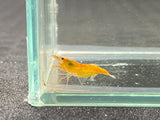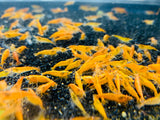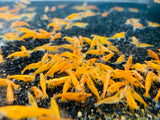
Sunkist shrimp, also known as Neocaridina davidi, are vibrant orange freshwater crustaceans that can add a splash of color to aquariums. They are known for being easy to care for and adaptable to a range of water conditions, making them suitable for both beginners and experienced aquarists.
-
Appearance:Sunkist shrimp have thick shells and vibrant orange coloration that can range from yellow-orange to red-orange. The first two generations can develop tiger designs, with yellow stripes at segment joints and a tail outline.
Neocaridina davidi
Characteristics
- Size: N. davidi are small, with females growing to a maximum size of 3–4 cm (1.2–1.6 inches) and males typically being slightly smaller.
- Temperament: They are peaceful scavengers that spend most of their time grazing on algae, biofilm, and decaying plant matter. In an aquarium, they help keep the tank clean.
-
Appearance: The wild-type coloration is a mottled greenish-brown. However, selective breeding has created numerous color morphs, including:
- Red: The most famous variety, often called Cherry, Sakura, or Fire Red shrimp.
- Yellow: Yellow Goldenback and Yellow Sakura shrimp.
- Blue: Blue Dream, Blue Velvet, and Blue Jelly shrimp.
- Green: Green Jade shrimp.
- Black/Brown: Black Rose and Chocolate shrimp.
- Patterned: Rili shrimp, which have translucent midsections with colored heads and tails.
- Sexual dimorphism: Females are larger and more vividly colored than males. They also develop a "saddle"—unfertilized eggs in their ovaries visible behind their head—and carry eggs, known as being "berried," under their tail.
Care and habitat
- Tank setup: Neocaridina are ideal for a species-only tank of at least 5 gallons, though a 10-gallon or larger tank offers more stability. They prefer heavily planted environments with features like driftwood, rocks, and leaf litter for grazing and hiding.
-
Water parameters: This species is tolerant of a wide range of conditions, but stability is key. They thrive in:
- Temperature: 68–78°F (20–25°C)
- pH: 6.5–8.0
- Hardness (GH): 6–8
- Ammonia/Nitrite: Always 0 ppm
- Nitrate: Below 20 ppm
- Diet: As omnivorous scavengers, their diet can be supplemented with high-quality shrimp pellets, algae wafers, blanched vegetables, and powdered foods for juveniles.
- Breeding: They are prolific and easy to breed in captivity. Females carry 20–40 eggs for 2–3 weeks, after which the young hatch as miniature versions of the adults (direct development).
- Caution: These shrimp are highly sensitive to copper, which is present in some plant fertilizers and medications. They also require a fully cycled and stable tank, as they are susceptible to rapid changes in water chemistry.
Sunkist/ Orange plus for DOA
We Also Recommend
Customer Reviews
Based on 2 reviews
Write a review


![[neo-caridinas] - Blue Crown Aquatics Trade](http://www.bluecrownaqua.com/cdn/shop/products/sunkist_{width}x.png?v=1684807364)




![[neo-caridinas] - Blue Crown Aquatics Trade](http://www.bluecrownaqua.com/cdn/shop/products/sunkist_compact.png?v=1684807364)



